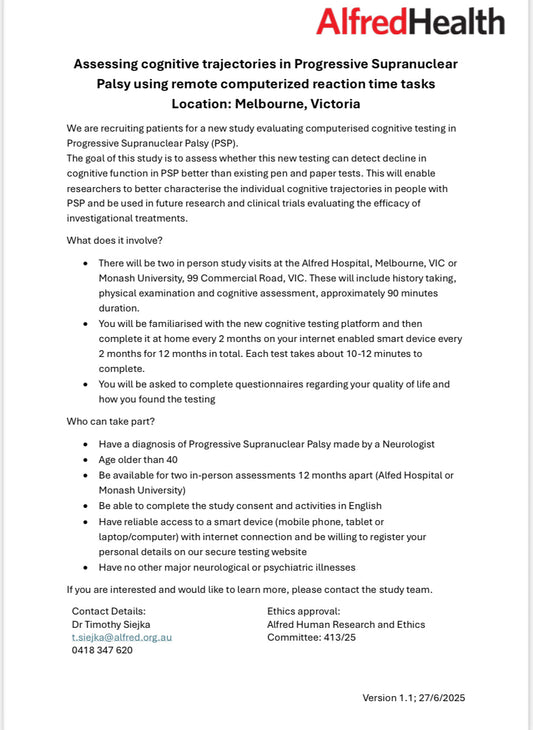It has been said there are four stages, but because there is so little research they are a guideline only.
Many people experience some stage four symptoms at stage one or overlap stages. Some never experience certain symptoms and then others can experience ones not listed. The impact it has on each individual varies dramatically.
Progressive Supranuclear Palsy (PSP) is a rare neurodegenerative disorder that affects movement, balance, vision, speech, and cognitive function. The disease progresses slowly over time, and its symptoms typically become more severe as the disease advances. While not everyone with PSP experiences the same symptoms or progression, there are generally four recognized stages of PSP:
-
Early stage: In the early stage of PSP, individuals may experience symptoms such as difficulty with balance and coordination, changes in gait, and problems with eye movement. These symptoms may be subtle and easily dismissed as normal aging or a different condition.
-
Mid-stage: In the mid-stage of PSP, symptoms become more pronounced and can include falls, speech and swallowing difficulties, and cognitive impairment such as problems with memory and executive function. Depression and apathy are also common.
-
Advanced stage: In the advanced stage of PSP, individuals may become wheelchair-bound and require assistance with daily activities such as eating, dressing, and bathing. Symptoms such as rigidity, spasticity, and involuntary movements become more severe.
-
End-of-life stage: In the end-of-life stage of PSP, individuals may be bedridden and require around-the-clock care. They may have difficulty swallowing, become more susceptible to infections, and experience other complications related to the progression of the disease.
It's important to note that not everyone with PSP will experience all of these stages, and the progression of the disease can vary widely from person to person. Additionally, some individuals may experience rapid progression, while others may experience a slower course of the disease.
Here is the four stages below in more detail;
Early stage:
May present via the fracture clinic, falls services, eye specialist or speech and language therapist. The early stage typically spans years 0-1.
> Ambulant.
> Occasional falls.
> Unsteadiness and poor balance.
> Possible visual problems affecting ability to read.
> Voice changes, for example reduced volume.
> Mood changes.
> Reduced socializing.
> Changes in mood and behavior, including apathy and anxiety.
Mid stage:
Many people reach this stage before diagnosis. Consider discussing advance care planning and advance decisions to refuse treatment. Consider referral to palliative care services. The mid stage typically spans years 2-3.
> Ambulant with aids.
> High risk of falls and injury.
> Visual problems affecting self-care abilities, for example eating and walking as unable to move eyes to see.
> Speech increasingly unintelligible.
> Inability to initiate conversation.
> Impulsivity (risky or impulsive behavior).
> Apathy.
> Dysphagia.
> High level of supervision required.
> Increasingly socially withdrawn.
Advanced stage:
Patients should be on GP palliative care register and have access to specialist palliative care.
The advanced stage typically spans years 3-6.
> Mobility significantly compromised, probably chair bound requiring a wheelchair for mobility.
> Significant visual problems.
> Significant muscle stiffness.
> Significant communication problems, but probably still able to understand.
> High risk of aspiration and pneumonia as a result of dysphagia.
> Pain.
> Increasing periods of sleepiness.
> Incontinence.
> Severely withdrawn socially.
> Dependent for most or all aspects of care.
End of life stage:
This stage is difficult to detect, but may be indicated by reduced levels of consciousness, inability to eat or drink, acute infection, a fall or major fracture, and rapid and significant weight loss. The end of life stage typically spans 6-8 weeks.
> Severe impairments and disabilities.
> Rapid and marked deterioration in condition.
> Decisions with regard to treatment interventions may be required, considering an individual’s previously expressed wishes (advance decisions to refuse treatment).
Discover the Benefits of Vielight Red Light Therapy for Atypical Parkinsonism


 Donate
Donate




129 comments
My husband has PSP he just turned 65 such an energetic man hard worker a jack of all trades. Now all I see is a man that needs tremendous help showering eating brushing his teeth etc etc. He has trouble walking he uses a walker he is loosing vision which makes it difficult for him to sit and watch tv. He’s a big fan of baseball these days all he does is listen to the games. I’m his care giver but I’m up there in age (67) I’m a diabetic and work part time. My husband needs more help due to his poor eye sight he has several accidents getting to the bathroom. Thank you to those that shared stories of a loved one dealing with this horrible decease.
Hi all. My father was diagnosed with psp in 2019. His condition has rapidly deteriorated. He is in a public hospital right now for over a month. He was taken there because he started vomiting blood and they found that he had gastric ulcer. While at home he was on a wheelchair able to eat food but had difficulty with water. He cant speak anymore. In hospital the doctor decided to do a gastrostomy (feeding tube in stomach) becasue they claimed he will choke if fed by mouth. After 3 weeks of been fed exclusive by drip feed they decided to feed him through the feeding tube. They fed him for two days and then they concluded that his stomach can’t digest the food. They said they will try again today more slowly and less portion. But they said there is a very large amount of liquid in his lungs and he will need to be transferred to another hospital. We are disappointed because he was “well” one month ago, at least he was at home, eating and enjoying the family. Is it the end of him? Or all this liquid in his lungs is due to his condition of lying on a bed in a hospital for over a month with no food and a very bad psychological condition?
Need psp support
My husband was diagnosed with PSP a month ago! He is 78. I’m trying to learn as much as I can about his disease! I’m worried and scared.
My husband was first diagnosed 3 years ago that something neurological was wrong. Now definite diagnosis of PSP as of a year ago. I believe him to be in advanced stage already, can’t walk, slurred and slow speech, chokes on eating and drinking. He is in a wheelchair or his recliner all the time. He just turned 65. He can hardly see anything and requires help with eating because can’t look down at his plate. He requires help with all aspects of personal care. Very quiet, stares into space, looks like he is in pain but denies pain if I ask. He has had to have a catheter full time for about 3 months now and occasionally has problems with bowel incontinence also. I had home care help until 2 weeks ago, when Medicaid got his coverage messed up. The past 2 weeks have been hard because I still work part time. I don’t really have anyone to talk to that understands what I’m going through, any suggestions would be appreciated. Thank you